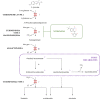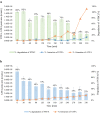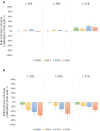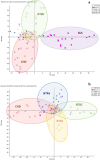Metabolic profiles and fingerprints for the investigation of the influence of nitisinone on the metabolism of the yeast Saccharomyces cerevisiae
- PMID: 36702867
- PMCID: PMC9879944
- DOI: 10.1038/s41598-023-28335-3
Metabolic profiles and fingerprints for the investigation of the influence of nitisinone on the metabolism of the yeast Saccharomyces cerevisiae
Abstract
Nitisinone (2-(2-nitro-4-trifluoromethylbenzoyl)-1,3-cyclohexanedione, NTBC) is considered a potentially effective drug for the treatment of various metabolic diseases associated with disorders of L-tyrosine metabolism however, side-effects impede its widespread use. This work aimed to broaden the knowledge of the influence of NTBC and its metabolites 2-amino-4-(trifluoromethyl)benzoic acid (ATFA), 2-nitro-4-(trifluoromethyl)benzoic acid (NTFA), and cyclohexane-1,3-dione (CHD) on the catabolism of L-tyrosine and other endogenous compounds in Saccharomyces cerevisiae. Based on a targeted analysis performed by LC-ESI-MS/MS, based on multiple reaction monitoring, it was found that the dissipation kinetics of the parent compound and its metabolites are compatible with a first-order reaction mechanism. Moreover, it has been proven that formed NTBC metabolites, such as CHD, cause a decrease in L-tyrosine, L-tryptophan, and L-phenylalanine concentrations by about 34%, 59% and 51%, respectively, compared to the untreated model organism. The overall changes in the metabolism of yeast exposed to NTBC or its derivatives were evaluated by non-targeted analysis via LC-ESI-MS/MS in the ion trap scanning mode. Based on principal components analysis, a statistically significant similarity between metabolic responses of yeast treated with ATFA or NTFA was observed. These findings facilitate further studies investigating the influence of NTBC on the human body and the mechanism of its action.
© 2023. The Author(s).
Conflict of interest statement
The authors declare no competing interests.
Figures






Similar articles
-
Influence of nitisinone and its metabolites on l-tyrosine metabolism in a model system.Chemosphere. 2022 Jan;286(Pt 1):131592. doi: 10.1016/j.chemosphere.2021.131592. Epub 2021 Jul 19. Chemosphere. 2022. PMID: 34311397
-
Inhibition of 4-hydroxyphenylpyruvate dioxygenase by 2-(2-nitro-4-trifluoromethylbenzoyl)-cyclohexane-1,3-dione and 2-(2-chloro-4-methanesulfonylbenzoyl)-cyclohexane-1,3-dione.Toxicol Appl Pharmacol. 1995 Jul;133(1):12-9. doi: 10.1006/taap.1995.1121. Toxicol Appl Pharmacol. 1995. PMID: 7597701
-
LC-MS/MS study of the degradation processes of nitisinone and its by-products.J Pharm Biomed Anal. 2019 Jul 15;171:15-21. doi: 10.1016/j.jpba.2019.03.046. Epub 2019 Mar 30. J Pharm Biomed Anal. 2019. PMID: 30959315
-
From toxicological problem to therapeutic use: the discovery of the mode of action of 2-(2-nitro-4-trifluoromethylbenzoyl)-1,3-cyclohexanedione (NTBC), its toxicology and development as a drug.J Inherit Metab Dis. 1998 Aug;21(5):498-506. doi: 10.1023/a:1005458703363. J Inherit Metab Dis. 1998. PMID: 9728330 Review.
-
The role of nitisinone in tyrosine pathway disorders.Curr Rheumatol Rep. 2014 Nov;16(11):457. doi: 10.1007/s11926-014-0457-0. Curr Rheumatol Rep. 2014. PMID: 25266991 Review.
Cited by
-
Metabolic profiling to evaluate the impact of amantadine and rimantadine on the secondary metabolism of a model organism.Sci Rep. 2023 Oct 5;13(1):16822. doi: 10.1038/s41598-023-43540-w. Sci Rep. 2023. PMID: 37798340 Free PMC article.
-
Cladosporium sphaerospermum extract inhibits quorum sensing associated virulence factors of Serratia marcescens.Biofilm. 2023 Aug 1;6:100146. doi: 10.1016/j.bioflm.2023.100146. eCollection 2023 Dec 15. Biofilm. 2023. PMID: 37560185 Free PMC article.
References
-
- Hereditary Tyrosinemia. in Advances in Experimental Medicine and Biology (ed. Tanguay, R. M.) 247 (Springer, 2017). 10.1007/978-3-319-55780-9. - PubMed
Publication types
MeSH terms
Substances
LinkOut - more resources
Full Text Sources
Molecular Biology Databases

